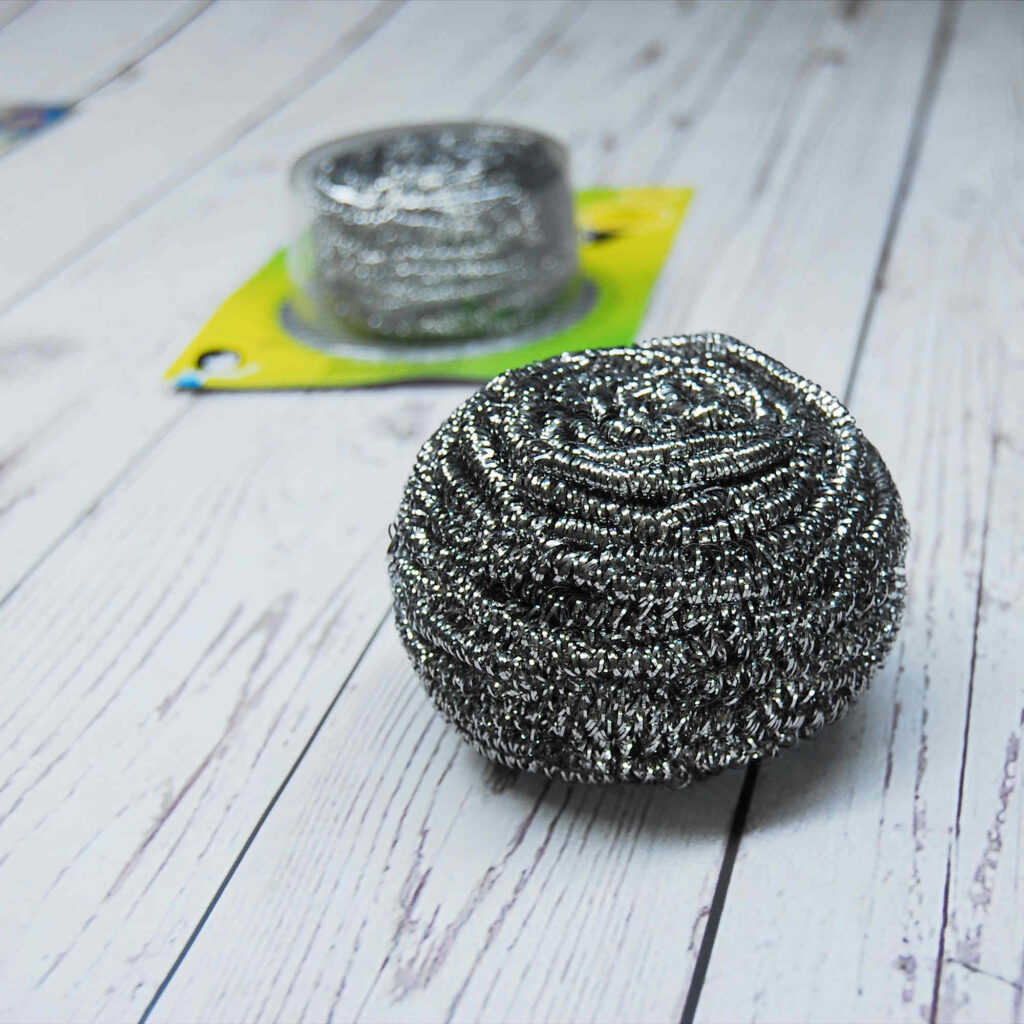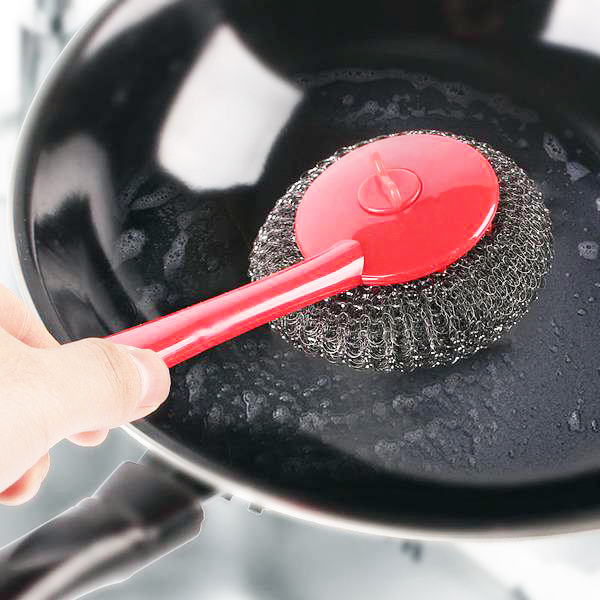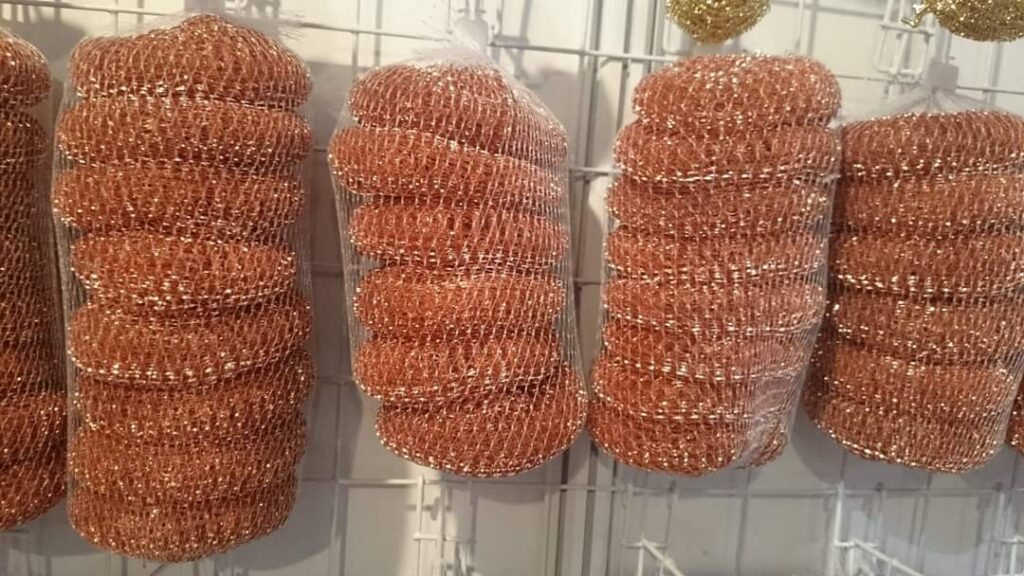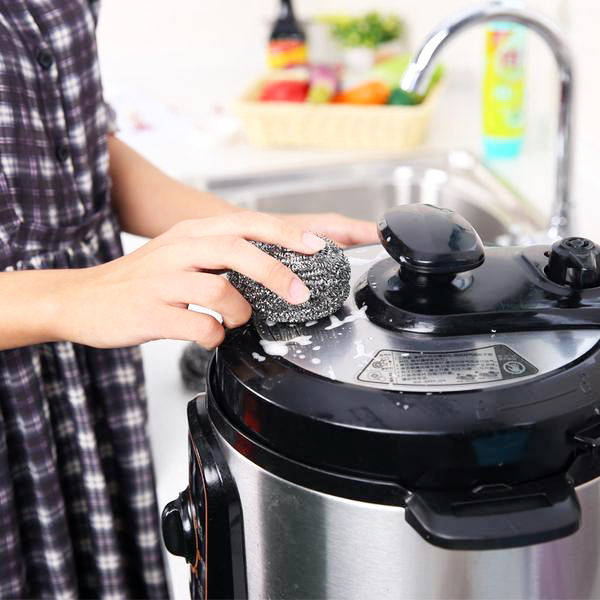In our daily life, we often use many tools to clean our homes and households and daily necessities, then Can I use stainless steel scrubbers on ceramic?
Yes, you can use stainless steel scrubbers on ceramic surfaces. Stainless steel scrubbers are generally safe to use on ceramic because they are non-abrasive and won’t scratch or damage the ceramic surface. However, it’s always a good idea to test a small, inconspicuous area first to ensure no adverse reaction or scratching. Also, use gentle pressure when scrubbing to avoid any potential damage.

When using a stainless steel sponge, it’s important to apply gentle pressure and avoid using it on delicate or sensitive surfaces that may be prone to scratching. Always follow the manufacturer’s instructions and test the sponge on a small, inconspicuous area before using it on the entire surface.
Where can I clean with stainless steel scrubbers?
- Kitchen: Stainless steel scrubbers are excellent for cleaning pots, pans, and baking sheets. They can help remove stubborn food residue and grime from stainless steel, cast iron, and non-stick surfaces.
- Bathroom: You can use stainless steel scrubbers to clean bathroom fixtures like sinks, faucets, and showerheads. They are effective in removing soap scum, hard water stains, and mineral deposits.
- Grills and BBQs: Stainless steel scrubbers are great for cleaning grills and BBQ grates. They can remove grease, charred residue, and food particles, helping to keep your grill in good condition.
- Outdoor furniture: If you have stainless steel or metal outdoor furniture, stainless steel scrubbers can be used to remove dirt, rust, and grime. They can restore the shine and cleanliness of your furniture.
- Tile and grout: Stainless steel scrubbers can be used on tile surfaces, such as kitchen backsplashes or bathroom tiles. They can help remove stains and grout discoloration.

Can you use copper scouring pads on stainless steel?

It is generally not recommended to use copper scouring pads on stainless steel surfaces. Copper is a softer metal compared to stainless steel, and using a copper scouring pad can potentially scratch or damage the stainless steel surface.
Stainless steel is known for its durability and resistance to corrosion, but it is still susceptible to scratching. To clean stainless steel, it is best to use cleaning tools and products specifically designed for stainless steel. Non-abrasive cleaning pads or sponges made from materials like nylon or polyester are safer options for cleaning stainless steel surfaces.
If you are unsure about a specific cleaning tool or method, it’s always a good idea to test it on a small, inconspicuous area of the stainless steel surface first to ensure it doesn’t cause any damage or scratches.

What is the difference between stainless steel and copper scrubbing pads?
The main difference between stainless steel scrubbing pads and copper scrubbing pads lies in the materials used to make them and their respective properties. Here are the key distinctions:
- Material: Stainless steel scrubbing pads are made of intertwined stainless steel wires, while copper scrubbing pads are made of copper or copper-coated wires. Stainless steel is an alloy of iron, chromium, and other elements, while copper is a naturally occurring metal.
- Abrasiveness: Stainless steel scrubbing pads are generally less abrasive compared to copper scrubbing pads. Stainless steel is harder than copper, which means it is less likely to scratch or damage surfaces. Copper scrubbing pads, on the other hand, are softer and can be more abrasive, which makes them effective for tackling tough stains and grime.
- Applications: Stainless steel scrubbing pads are commonly used for cleaning stainless steel, pots, pans, and other cookware, as well as various surfaces in the kitchen and bathroom. They are non-abrasive and won’t scratch most surfaces. Copper scrubbing pads are often used for heavy-duty cleaning tasks, such as removing stubborn burnt-on food, rust, or stains from metal surfaces. They can be more abrasive, so caution is needed when using them on delicate or easily scratched surfaces.
- Reactivity: Copper is a reactive metal that can oxidize and develop a greenish patina over time when exposed to certain elements. Stainless steel, on the other hand, is highly resistant to corrosion and does not react in the same way as copper. This makes stainless steel scrubbing pads a better choice for long-term durability and resistance to rust or tarnish.
When choosing between stainless steel scrubbing pads and copper scrubbing pads, consider the specific cleaning task and the surface you are cleaning. If you are concerned about scratching or damaging the surface, it is generally safer to opt for stainless steel scrubbing pads.

Should you use steel wool on stainless steel?
Using steel wool on stainless steel surfaces is generally not recommended. Steel wool is made of fine steel strands that are woven together, and it is abrasive in nature. While stainless steel is durable and resistant to corrosion, it is still susceptible to scratching.
Using steel wool on stainless steel can cause scratches and damage the surface, which may compromise the appearance and integrity of the stainless steel. The scratches can also make the surface more prone to staining and corrosion over time.
Instead of steel wool, it is advisable to use non-abrasive cleaning tools specifically designed for stainless steel. Soft cloths, microfiber pads, or non-abrasive scrubbing pads made from materials like nylon or polyester are better choices for cleaning stainless steel surfaces. These alternatives can effectively clean and remove dirt, stains, and fingerprints without scratching the stainless steel.
If you encounter stubborn stains or grime on stainless steel, you can also use mild, non-abrasive cleaning agents or stainless steel cleaners recommended for the specific purpose. Always follow the manufacturer’s instructions and test any cleaning product or tool on a small, inconspicuous area first to ensure compatibility with the stainless steel surface.

What grade of steel wool is best for stainless steel if you want to use steel wool to clean stainless steel?
When it comes to using steel wool on stainless steel, it is generally recommended to use the finest grades available to minimize the risk of scratching or damaging the surface. In this case, the best grade of steel wool for stainless steel would be Grade 0000.
Grade 0000 steel wool is extremely fine and has a very soft texture. It is often referred to as “superfine” or “extra fine” steel wool. This grade is specifically designed for delicate or sensitive surfaces, including stainless steel. It is less likely to cause scratches or leave visible marks on the stainless steel.
When using Grade 0000 steel wool on stainless steel, it is still important to exercise caution. Apply gentle pressure and use it in combination with a suitable stainless steel cleaner or lubricant to minimize friction and reduce the risk of scratching. Always test the steel wool on a small, inconspicuous area first to ensure it does not cause any damage or undesirable effects on the stainless steel surface.



